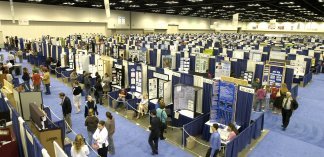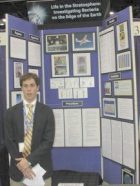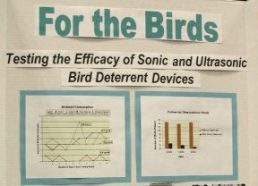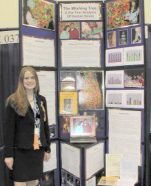The Science Fair Circuit
For some kids, entering science fairs is like eating cookies. It's hard to stop at just one.
Share this:
- Share via email (Opens in new window) Email
- Click to share on Facebook (Opens in new window) Facebook
- Click to share on X (Opens in new window) X
- Click to share on Pinterest (Opens in new window) Pinterest
- Click to share on Reddit (Opens in new window) Reddit
- Share to Google Classroom (Opens in new window) Google Classroom
- Click to print (Opens in new window) Print
By Emily Sohn
For some kids, entering science fairs is like eating cookies. It’s hard to stop at just one.
The research is interesting, these students say. The competitions are exciting, and you can win prizes. Best of all, joining the science fair circuit is a great way to make friends.
“I like meeting kids who are also passionate about science,” says Peter Borden, now an 11th grader at Seacrest School in Naples, Fla.
 |
|
The annual Intel International Science and Engineering Fair brings together nearly 1,500 students from around the world. |
| Intel |
Peter, 15, traveled to Indianapolis last May to present his most recent discovery—that bacteria unexpectedly live at the upper edge of Earth’s atmosphere. He was one of nearly 1,500 high school students from 47 countries to compete at the 2006 Intel International Science and Engineering Fair (ISEF).
Of these 1,500 kids, Peter belonged to a group of 31 students who had previously competed in the Discovery Channel Young Scientist Challenge (DCYSC). The DCYSC brings together 40 of the nation’s top middle school science fair winners each year for an action-packed, team competition.
Both DCYSC and ISEF are organized by Science Service, a nonprofit organization that publishes Science News magazine and Science News for Kids.
Getting there
In order to qualify for ISEF, high school students must work their way through as many as four local, state, and regional fairs, placing at or near the top of each. It’s a rigorous process, but Peter and his colleagues say that their DCYSC experience helped them get there.
 |
|
Peter Borden of Naples, Fla., presented his research on bacteria in the upper atmosphere at the 2006 ISEF. |
| V. Miller |
Perhaps most useful of all, they say, DCYSC makes a big deal out of communication. This competition doesn’t reward participants simply for the results of their research. Its prizes go to students who can also speak clearly, even when talking about challenging fields, such as astrophysics or molecular biology.
“I used to talk with complex words,” Peter says. “Now that I’ve been to DCYSC, I know I have to talk to people in their terms.”
Noise makers
Joanna Guy, a 10th grader at Southern Garrett High School in Oakland, Md., has honed both her communications skills and her research skills as a result of competing in science fairs. She’s also gained self-confidence.
Talking to the judges, she says, entails “telling them about the project and why it’s important. You don’t have to be afraid of them.”
Speaking clearly is important. When Joanna explained her research to me, she got straight to the point.
“I think our country needs to decrease its dependence on foreign oil,” she says.
Joanna believes that wind turbines could be a great way to produce energy (see “Power of the Wind”). But some people have argued that windmills kill too many bats and birds to be worth the investment.
 |
|
Joanna Guy discovered that loud noises can keep birds away from feeders. She presented her research at this year’s ISEF. |
| V. Miller |
Joanna designed an experiment that she hoped would help resolve this disagreement. She hung bird feeders in her backyard. Then, she used a machine called the Bird-X Critter Blaster Pro to blast loud, annoying sounds into the air. At other times, she played a device that emitted ultrasonic signals.
Joanna found that the birds ate far fewer seeds when the audible sounds were blaring than when she played the ultrasonic device or no sound at all. The blasting noise evidently disturbed the birds more.
Windmills that scream, Joanna proposes, could create energy in an environment-friendly and animal-friendly way. Their noise would keep the birds away. She plans next to investigate other possible bird deterrents, such as infrasound or strobe lights.
A single idea
For some kids, a single idea sparks a project that lasts for years. These students begin presenting their research at DCYSC, and then continue with presentations on the same topic at ISEF. That happened to Kelydra Welcker (see “Pollution Detective”) with mosquitoes and environmental toxins and Erica David (see “Snow Traps”) with snow.
Liz Baker of Tucson, Ariz., who’s now in college, was a DCYSC competitor who participated in ISEF four times. Unlike Kelydra and Erica, Liz focused on different subjects throughout the years. But in 2006, she returned to a project that she’d started in seventh grade.
 |
|
Liz Baker with her “Wishing Tree” project at the 2006 ISEF. |
| V. Miller |
When she began the work, the new millennium had just started. At the time, the media were producing reports about how self-centered and shopping-focused people in the United States had become.
“I didn’t believe it,” says Liz, 17. “I wanted to either prove them wrong or give the media validation.”
The best way to find out what really matters to people, Liz thought, is to learn more about their deepest dreams. So, she turned a huge pine tree in her front yard into a “Wishing Tree.” Her street is famous for its Christmas decorations, so over the holiday season, she asked people stopping by to write down their wishes and hang the anonymous notes on the tree.
She did this for 6 years. She collected 29,095 wishes.
When Liz analyzed the notes that people had posted, she found some interesting trends. She could even track fads: For example, people expressed fewer wishes for scooters as iPods became more popular.
She also noticed a shift after the 9/11 terrorist attacks in 2001. That year, people made selfish wishes only 40 percent of the time, compared with 70 percent the year before.
Even though selfish wishes rebounded in the following years, Liz was happy to see that a significant number of wishes had nothing to do with toys, gadgets, or other stuff.
“It gives me hope that people wish for love, peace, health, and happiness,” she says.
Keep trying
During their work, Liz and the other young researchers learned that all scientists experience setbacks. The number-one rule, these participants now know, is to never give up.
“Keep entering,” Liz says. “Keep trying!”
Going Deeper:






